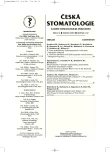Most Frequent Contact Allergens of Oral Cavity and Lips
Nejčastější kontaktní alergeny ústní dutiny a rtů
Ústní dutina je opakovaně nebo trvale exponována širokému spektru látek, z nichž mnohé mají iritační a senzibilizační potenciál. Osoby podstupující stomatologické ošetření a užívající prostředky orální hygieny jsou vystavovány stále rostoucímu množství nových a technologicky složitějších biomateriálů, které mohou v důsledku přecitlivělosti vést k dyskomofortu v ústní dutině. Práce podává přehled hlavních skupin kontaktních alergenů v ústní dutině, včetně rtů, s důrazem na dentální kovy a syntetické pryskyřice. Příčinou kontaktní stomatitidy, event. cheilitidy, mohou být i četné topicky působící léčivé a dezinfekční přípravky, včetně fytoterapie, dále potraviny, pochutiny a nápoje spolu s aditivy. Hlavní vyšetřovací metodou jsou uzavřené epikutánní testy, jako vyhledávací jsou doporučovány sady „Evropský standard“ a „Dental Screening“ (Chemotechnique Diagnostics), doplněné o speciální testy dle anamnestických údajů.
Klíčová slova:
ústní dutina – kontaktní stomatitida a cheilitida - kontaktní alergeny – dentální kovy – syntetické pryskyřice – epikutánní testy
Authors:
D. Ditrichová 1; J. Dobešová 1; S. Kaprálová 2; M. Eber 2; H. Steigerová 2
Authors‘ workplace:
Klinika chorob kožních a pohlavních LF UP a FN, Olomouc
přednostka doc. MUDr. D. Ditrichová, CSc.
1; Klinika zubního lékařství LF UP a FN, Olomouc
přednosta prof. MUDr. M. Eber, CSc.
2
Published in:
Česká stomatologie / Praktické zubní lékařství, ročník 107, 2007, 2, s. 39-45
Category:
Comprehensive Report
Overview
Oral cavity is frequently or permanently exposed to a wide spectrum of compounds, some of which possess irritation or sensitization potential. Persons who are subjected to stomatological treatment and use oral hygiene are exposed to growing number of new, technologically more complex biomaterials, which may lead, due to hypersensitivity, to discomfort in oral cavity. The paper provides a survey of the main groups of contact allergens of oral cavity including lips with emphasis to dental metals and synthetic resins. The cause of contact stomatitis or cheilitis may also be frequent topically acting therapeutic and disinfection preparations including phytotherapy, foods, spices and ingredients and drinks together with additives. Standard epicutaneous (patch) tests represent the main method of examination for the demonstration of contact hypersensitivity, legally binding from the forensic standpoint. Their principle lays in the exposure of a small skin area to a suspect allergen for 48h in occlusion conditions. The recommended finding tests are the “European standard” sets with 25 most often European allergens (nickel, chromium, cobalt, perfumes, epoxides, Peruvian balsam, formaldehyde etc.) and the series “Dental Screening” with 25 most frequently orally used dental materials (acrylates, additives of polymerization, mercury, palladium, tin, copper etc.) supplemented by amalgam, iridium, indium, platinum, menthol and sorbic acid. A detailed anamnesis, interdisciplinary collaboration with dentists and correctly performed epicutaneous tests are prerequisites for discovery of the source of contact sensitization in oral cavity and a causal treatment.
Key words:
oral cavity – contact stomatitis and cheilitis – contact allergens – dental metals – synthetic resins – patch tests
Labels
Maxillofacial surgery Orthodontics Dental medicineArticle was published in
Czech Dental Journal

2007 Issue 2
- What Effect Can Be Expected from Limosilactobacillus reuteri in Mucositis and Peri-Implantitis?
- The Importance of Limosilactobacillus reuteri in Administration to Diabetics with Gingivitis
Most read in this issue
- Most Frequent Contact Allergens of Oral Cavity and Lips
- Influence of Acidic Environment on Oral Cavity in Patients with Gastroesophageal Reflux
- Prosthetic Stage of Implant Treatment in Missing Incisor Cases
- II. Titanium Modified with Hydroxyapatite and Zirconium – Biological Properties
